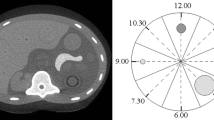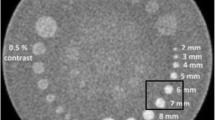Abstract
Purpose
To assess the dose performance in terms of image quality of filtered back projection (FBP) and two generations of iterative reconstruction (IR) algorithms developed by the most common CT vendors.
Materials and methods
We used four CT systems equipped with a hybrid/statistical IR (H/SIR) and a full/partial/advanced model-based IR (MBIR) algorithms. Acquisitions were performed on an ACR phantom at five dose levels. Raw data were reconstructed using a standard soft tissue kernel for FBP and one iterative level of the two IR algorithm generations. The noise power spectrum (NPS) and the task-based transfer function (TTF) were computed. A detectability index (d′) was computed to model the detection task of a large mass in the liver (large feature; 120 HU and 25-mm diameter) and a small calcification (small feature; 500 HU and 1.5-mm diameter).
Results
With H/SIR, the highest values of d′ for both features were found for Siemens, then for Canon and the lowest values for Philips and GE. For the large feature, potential dose reductions with MBIR compared with H/SIR were − 35% for GE, − 62% for Philips, and − 13% for Siemens; for the small feature, corresponding reductions were − 45%, − 78%, and − 14%, respectively. With the Canon system, a potential dose reduction of − 32% was observed only for the small feature with MBIR compared with the H/SIR algorithm. For the large feature, the dose increased by 100%.
Conclusion
This multivendor comparison of several versions of IR algorithms allowed to compare the different evolution within each vendor. The use of d′ is highly adapted and robust for an optimization process.
Key Points
• The performance of four CT systems was evaluated by using imQuest software to assess noise characteristic, spatial resolution, and lesion detection.
• Two task functions were defined to model the detection task of a large mass in the liver and a small calcification.
• The advantage of task-based image quality assessment for radiologists is that it does not include only complicated metrics, but also clinically meaningful image quality.






Similar content being viewed by others

Abbreviations
- CTDI:
-
CT dose index
- CTDIvol :
-
Volume CT dose index
- ESF:
-
Edge-spread function
- FBP:
-
Filtered back projection
- H/SIR:
-
Hybrid or statistical iterative reconstruction
- IR:
-
Iterative reconstruction
- LSF:
-
Line-spread function
- MBIR:
-
Full or advanced or partial model-based iterative reconstruction
- NPS:
-
Noise power spectrum
- TTF:
-
Task-based transfer function
References
Katsura M, Matsuda I, Akahane M et al (2012) Model-based iterative reconstruction technique for radiation dose reduction in chest CT: comparison with the adaptive statistical iterative reconstruction technique. Eur Radiol 22:1613–1623
Larbi A, Orliac C, Frandon J et al (2018) Detection and characterization of focal liver lesions with ultra-low dose computed tomography in neoplastic patients. Diagn Interv Imaging 99:311–320
Macri F, Greffier J, Pereira F et al (2016) Value of ultra-low-dose chest CT with iterative reconstruction for selected emergency room patients with acute dyspnea. Eur J Radiol 85:1637–1644
Yamada Y, Jinzaki M, Hosokawa T et al (2012) Dose reduction in chest CT: comparison of the adaptive iterative dose reduction 3D, adaptive iterative dose reduction, and filtered back projection reconstruction techniques. Eur J Radiol 81:4185–4195
Yan C, Xu J, Liang C et al (2018) Radiation dose reduction by using CT with iterative model reconstruction in patients with pulmonary invasive fungal infection. Radiology. 288:285–292
Patino M, Fuentes JM, Hayano K, Kambadakone AR, Uyeda JW, Sahani DV (2015) A quantitative comparison of noise reduction across five commercial (hybrid and model-based) iterative reconstruction techniques: an anthropomorphic phantom study. AJR Am J Roentgenol 204:W176–W183
Viry A, Aberle C, Racine D et al (2018) Effects of various generations of iterative CT reconstruction algorithms on low-contrast detectability as a function of the effective abdominal diameter: a quantitative task-based phantom study. Phys Med 48:111–118
McCollough CH, Chen GH, Kalender W et al (2012) Achieving routine submillisievert CT scanning: report from the summit on management of radiation dose in CT. Radiology 264:567–580
Thibault JB, Sauer KD, Bouman CA, Hsieh J (2007) A three-dimensional statistical approach to improved image quality for multislice helical CT. Med Phys 34:4526–4544
Verdun FR, Racine D, Ott JG et al (2015) Image quality in CT: from physical measurements to model observers. Phys Med 31:823–843
Samei E, Richard S (2015) Assessment of the dose reduction potential of a model-based iterative reconstruction algorithm using a task-based performance metrology. Med Phys 42:314–323
Willemink MJ, Noël PB (2019) The evolution of image reconstruction for CT-from filtered back projection to articial intelligence. Eur Radiol 29:2185–2195
IEC. 60601–2-44 (2002) Medical electrical equipment –. Part 2–44: Particular requirements for the safety of. X-ray equipment for computed tomography. Edition 2.1
Solomon J, Zhang Y, Wilson J, Samei E (2018) An automated software tool for task-based image quality assessment and matching in clinical CT using the TG-233 Framework, Med Phys 45:E134 - E134
Christianson O, Chen JJ, Yang Z et al (2015) An improved index of image quality for task-based performance of CT iterative reconstruction across three commercial implementations. Radiology 275:725–734
Richard S, Husarik DB, Yadava G, Murphy SN, Samei E (2012) Towards task-based assessment of CT performance: system and object MTF across different reconstruction algorithms. Med Phys 39:4115–4122
Burgess AE, Li X, Abbey CK (1997) Visual signal detectability with two noise components: anomalous masking effects. J Opt Soc Am A Opt Image Sci Vis 14:2420–2442
Burgess AE, Wagner RF, Jennings RJ, Barlow HB (1981) Efficiency of human visual signal discrimination. Science 214:93–94
Eckstein M, Bartroff J, Abbey C, Whiting J, Bochud F (2003) Automated computer evaluation and optimization of image compression of x-ray coronary angiograms for signal known exactly detection tasks. Opt Express 11:460–475
Ishida M, Doi K, Loo LN, Metz CE, Lehr JL (1984) Digital image processing: effect on detectability of simulated low-contrast radiographic patterns. Radiology 150:569–575
Aurumskjöld ML, Ydström K, Tingberg A, Söderberg M (2017) Improvements to image quality using hybrid and model-based iterative reconstructions: a phantom study. Acta Radiol 58:53–61
Euler A, Solomon J, Marin D, Nelson RC, Samei E (2018) A third-generation adaptive statistical iterative reconstruction technique: phantom study of image noise, spatial resolution, lesion detectability, and dose reduction potential. AJR Am J Roentgenol 210:1301–1308
Greffier J, Macri F, Larbi A et al (2016) Dose reduction with iterative reconstruction in multi-detector CT: what is the impact on deformation of circular structures in phantom study? Diagn Interv Imaging 97:187–196
Paruccini N, Villa R, Pasquali C, Spadavecchia C, Baglivi A, Crespi A (2017) Evaluation of a commercial model based iterative reconstruction algorithm in computed tomography. Phys Med 41:58–70
Solomon J, Mileto A, Ramirez-Giraldo JC, Samei E (2015) Diagnostic performance of an advanced modeled iterative reconstruction algorithm for low-contrast detectability with a third-generation dual-source multidetector CT scanner: potential for radiation dose reduction in a multireader study. Radiology 275:735–745
Ott JG, Becce F, Monnin P, Schmidt S, Bochud FO, Verdun FR (2014) Update on the non-prewhitening model observer in computed tomography for the assessment of the adaptive statistical and model-based iterative reconstruction algorithms. Phys Med Biol 59:4047–4064
Akagi M, Nakamura Y, Higaki T et al (2019) Deep learning reconstruction improves image quality of abdominal ultra-high-resolution CT. Eur Radiol. https://doi.org/10.1007/s00330-019-06170-3
Acknowledgments
We are deeply grateful to Dr. J. Solomon for support regarding the use of imQuest software. We would like to thank Pr H. Rousseau and Dr. J.M. Teissier for giving us permission to use their measurement results.
Funding
The authors state that this work has not received any funding.
Author information
Authors and Affiliations
Corresponding author
Ethics declarations
Guarantor
The scientific guarantor of this publication is Jean Paul Beregi.
Conflict of interest
The authors of this manuscript declare no relationships with any companies, whose products or services may be related to the subject matter of the article.
Statistics and biometry
No complex statistical methods were necessary for this paper.
Informed consent
Written informed consent was not required for this study because it’s a phantom study.
Ethical approval
Institutional Review Board approval was not required because it’s a phantom study.
Methodology
• experimental
• multicenter study
Additional information
Publisher’s note
Springer Nature remains neutral with regard to jurisdictional claims in published maps and institutional affiliations.
Rights and permissions
About this article
Cite this article
Greffier, J., Frandon, J., Larbi, A. et al. CT iterative reconstruction algorithms: a task-based image quality assessment. Eur Radiol 30, 487–500 (2020). https://doi.org/10.1007/s00330-019-06359-6
Received:
Revised:
Accepted:
Published:
Issue Date:
DOI: https://doi.org/10.1007/s00330-019-06359-6



